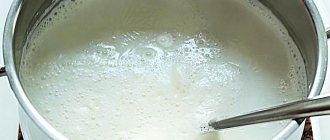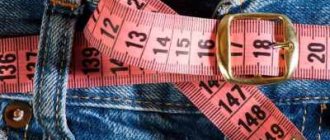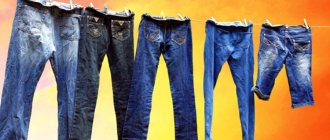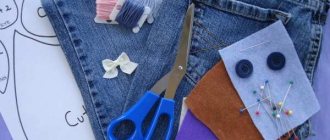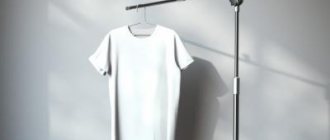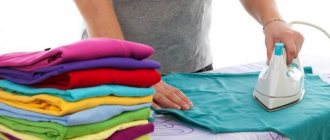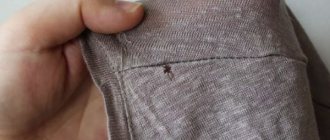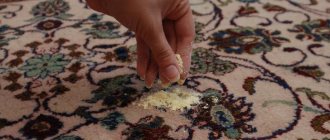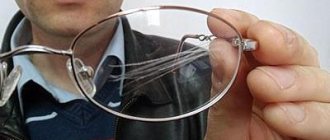Jeans are an indispensable item of clothing that is used to create a casual style or an original fashionable look. And denim fans often have questions: do they need to iron jeans and how to do it correctly. Our tips will help you understand the features of ironing such clothes.
Ironing will help restore your jeans to their original appearance after washing. Follow the basic recommendations to avoid the appearance of shiny streaks, arrows or creases
If necessary?
Denim is a material that lends itself well to ironing . If you do everything correctly, your favorite pair of trousers will not deteriorate, but will even become softer. This will also provide greater comfort when wearing denim trousers.
Ironing jeans is not necessary, if the trousers are not wide and have been properly washed and dried according to all the rules, you can do without it.
Situations when ironing is recommended:
- For straightening wrinkled fabric.
- To give the product softness.
Brush-effect (Washed jeans)
Can be achieved manually and mechanically (chemically). For the manual method, as a rule, ordinary sandpaper is used. It's simple, the more you want to whiten the surface, the harder you rub the area. It is noteworthy that the person performing this operation does not know what exactly will happen in the end, because after this operation the jeans will go further along the conveyor belt, where they will be washed and dried properly, so in order to know how to make jeans worn to The desired shade requires considerable experience and care. It is quite possible to create the effect of worn jeans at home using pumice or sandpaper, after making several samples and recording the time spent on the effect, as well as describing the degree of pressure applied.
The machine method requires special equipment. In large factories there is a special workshop (sand-room), where a special machine directs the flow of sand to the desired location, adjusting the flow time and force. After which the jeans are washed again and dried thoroughly.
Which is correct?
Proper ironing of jeans is necessary according to the following instructions :
Turn the pants inside out.- If the fabric is completely dry, then the jeans should be moistened with water using a container with a spray bottle.
- Set the iron to ironing mode.
- Place fabric folded several times into the pockets so that the seams do not appear as a print on the front side of the jeans.
- You should start ironing from the waist area.
- Iron the top of the trousers by putting them on the narrow side of the ironing board.
- Pay attention to the back pocket area.
- After the top is ironed, the trousers are removed and laid out along the ironing board. Each trouser leg is ironed separately.
- The trouser legs are ironed starting from the side and inner seams. They are ironed without strong pressure, first on one side, then on the other.
- After ironing the front, leave the jeans flat to cool and dry completely.
It is advisable to straighten jeans with a large number of decorative elements and embellishments using a steam generator.
If you use an iron, you need to lay additional fabric when ironing, avoiding contact between the heating surface and the decor.
Which jeans can't be ironed?
Those that have it written on the label.
It is highly not recommended to iron stretch jeans, such as skinny jeans. They will smooth out on the hostess anyway. Heat treatment will cause the item to become one size larger.
Products with rich decor in the form of rhinestones, sequins, sparkles, spikes, lace should be ironed only from the wrong side, in order to avoid damage to the item and the iron. There are also jeans with a “wrinkled” effect - you shouldn’t correct the intention of the creator of these pants, that’s how it was intended.
Features depending on the density of denim fabric
Denim fabric comes in several types , which differ in density, including mixed ones. Features of the composition affect the degree of intensity of thermal exposure when ironing.
This factor must be taken into account when ironing:
Thick denim without any synthetic fibers .
Thick jeans, the label of which says “100% cotton”, are made from natural cotton. This fabric is highly durable and is considered traditional for denim clothing.If desired, these denim trousers can be ironed at high temperature (180-200ºC) to straighten the fabric and soften the material.
- Medium weight fabrics .
Medium density material often has various additives in small quantities. After washing, these trousers become rougher, and if not dried properly, they may have creases and unsightly folds. To eliminate defects and make the fabric softer, they are ironed at temperatures up to 150ºC. If the temperature is exceeded, damage to the material and deformation of the fabric is possible. - Thin denim . This group includes fairly thin denim fabrics (denim-silk, chambray). They wrinkle after washing and require ironing. The optimal temperature setting for the iron is 110ºС.
Features of ironing jeans
The denim fabric from which trousers are made can be dense and rough or delicate and thin. This is an important point that should not be missed if you need to iron your jeans without causing harm to them. Taking into account some of the features of working with an iron, in a few minutes the pants will look perfect, without wrinkles.
Which side to iron jeans from?
Denim can be ironed on any side. But it is still more often recommended to iron the reverse part of the product. This is especially true for black denim.
The thing is that after ironing, if you don’t guess the temperature correctly, a shiny iron mark or even a scorch mark may remain on things. So it’s better not to take risks, especially if you have to iron your jeans for the first time.
At what temperature should you iron jeans?
The quality of ironing, as well as the appearance of jeans, directly depend on the selected temperature setting of the iron. All the necessary information is usually indicated on the product label. As a rule, this temperature is 150-200 degrees.
Attention! Jeans made from thick, coarse fabrics should be ironed at a high temperature, while delicate jeans should be ironed at lower temperatures.
But sometimes it happens that the tag on the product is missing. In this case, you will have to select the mode for ironing your jeans yourself. This should be done from the inside out in such a section of the product that random scorch marks are not visible.
What mode should you use to iron jeans?
It is best to iron jeans using the steam setting. Steam will help get rid of bruises faster. Thick fabric, which is most often used for sewing pants, is recommended to be ironed on mode No. 3, which means “cotton”.
We recommend reading: How to wash a backpack in the washing machine: leather, orthopedic, school
Steamer and steam generator
A steamer and steam generator can be used to iron jeans.
Using the steamer:
- purified water is poured into the steamer;
- clothes are hung up, straightened;
- turn on the steamer;
- pulling the fabric, run an iron over it.
The treatment is carried out with vertical movements from top to bottom. After processing is completed, the item is left to hang for some time.
The steam generator is similar to a regular iron and provides dry steam . The power of the device allows you to iron even very thick jeans.
This video will show you how to iron jeans without an iron:
Alternative methods
What to do if the iron stops working or the electricity suddenly goes out? Fortunately, these are not hopeless situations!
A hair straightening iron “works” almost the same as a regular iron. It is unlikely to eliminate large folds and creases, but in any case, the jeans will look fresher and neater.
- Why not replace an iron with a pan of hot water or a hot cast iron frying pan? A pan of boiling water is an excellent alternative to a steam generator. If holding your pants over boiling water is inconvenient, another option is to fill the bathtub with hot water and hang your jeans over it.
- The easiest way to solve the problem is in the summer - you need to put on wet jeans. They will dry and straighten naturally. True, the method does not “work” with all models, but only with rather narrow and straight ones.
- Wide trouser legs will have to be straightened and laid out on a flat surface. It is advisable to press it down with something heavy. Books, boards, water containers, boxes, and a mattress are suitable. The improvised press does not “work” quickly: things will have to stay under it for several hours.
Clothing spray or “liquid iron” not only smooths out wrinkles in fabric, but also deodorizes and disinfects it. Apply the product to clothing until it becomes slightly damp. Existing folds are smoothed out with your hands, and then the jeans are either laid out or hung so that new creases and folds cannot appear on them.
A homemade mixture of table vinegar, water and fabric softener gives a similar effect.
The proposed methods are universal. This means that you can put any other denim products in order in the same way - shirts, jackets, skirts, dresses, backpacks. And most importantly, some of them cause virtually no trouble, which means they are unlikely to cause negative thoughts like this: “Why iron if your pants will wrinkle anyway.”
Is it possible to do without an iron?
If you don’t have an iron, a steamer, or a steam generator at hand, you can straighten your jeans in various ways:
- Using improvised means.
- Using steam.
Each of the ironing methods without an iron allows you to straighten the fabric of denim trousers very effectively . It is also important to adhere to certain rules.
Steam bath
If time permits, you can arrange for the denim to be straightened over hot steam.
This can be organized as follows:
- pour boiling water into the bathroom so that hot steam rises;
- hang jeans over the bathtub so that the trousers hang freely but do not touch the water;
- leave the trousers for several hours;
- hang the jeans in a dry place.
Jeans should dry freely, without touching other things.
Quick and slow-acting means at hand
When jeans need to be straightened quickly, and there is practically no free time, you can use improvised means :
- Boiling water poured into a saucepan or metal mug. Hot water is not poured into the container to the very top, so as not to splash. The trousers are laid out as evenly as possible and gently smoothed using a container of boiling water. If the creases are very strong, then the fabric should be slightly moistened beforehand.
- Using the press. Pressure for the purpose of smoothing can be applied if the trousers are carefully spread under the mattress of the bed. This method requires sufficient free time, and may not help if the item is heavily wrinkled.
How to care for jeans without ironing them too often
It is not recommended to iron real jeans frequently because it is unnatural to their nature. Regular ironing will lead to the appearance of numerous creases and loss of the visual naturalness of the fabric.
To keep your jeans looking neat after washing, try not to wring them out. Let the water drain naturally from trousers that have been previously straightened and secured on a hanger or on a horizontal surface in a ventilated area, outdoors, but not in direct sunlight.
An interesting example from the 80s - in order not to iron jeans, they washed them without taking them off. Hipsters believed that this was the only way the trousers would retain their shape and color. But this, by the way, in our time this approach seems more extreme than the norm.
In general, jeans most likely won't need to be ironed if you wash and dry them properly. Civilized, gentle care will not only eliminate ironing, but will also extend the service life of trousers.
How to avoid ironing after washing?
Proper washing and drying is the easiest way to avoid ironing . Wash jeans at a temperature no higher than 40ºС, and do not set high spin speeds.
After washing by hand, jeans should not be twisted. The fabric is wrung out, avoiding twisting and creasing of the material.
Dry your trousers straight out . Best of all - in limbo. Using your hands, you need to carefully straighten the fabric, smooth out the burlap of the pockets, and fasten the zipper.
Tips and tricks
Frequent ironing of denim can be avoided if you follow some recommendations:
- Do not throw things into the machine, but wash them by hand in warm water (not higher than 40 degrees). Use laundry soap as a detergent.
- Wash jeans by first turning them inside out. Zippers, locks, and buttons must be fastened.
- You need to work carefully so that kinks do not appear on the dense fabric.
- Twisting your pants is not recommended. They need to be shaken well and hung so that the water gradually flows into the basin.
- Drying is best done outside or on the balcony with the window open.
- If you have a special bag in your arsenal, then it is best to wash your jeans in it, also inside out and with zippers and buttons fastened.
- It is recommended to iron jeans, including black ones, when wet. This way you can quickly remove kinks and creases left after washing. If things are dry, then they should be sprayed with a spray bottle and use the steaming mode.
- You need to start ironing from the waistband and pockets, carefully going through all the seams.
Advice! To make ironing more convenient, it is first advisable to stretch the pant legs a little with your hands.
At what temperature should this be done so as not to ruin the pants?
To properly iron trousers or a denim shirt, you need to follow a few simple conditions.
- You have to turn your pants inside out.
- It is better to iron undried items. If they are dry, then spray with a spray bottle. When you don’t have that either, you can take wet gauze, a napkin, or a light, thin cotton scarf.
- The temperature must be selected in accordance with the information on the label. Typically recommendations range from 150 to 200 degrees.
- It is better to start the procedure from your pockets, placing a small handkerchief there in advance. If this is not done, thick seams will leave their mark on the outside.
- The steam from the iron can only smooth out the smallest wrinkles, so additional moisture is required.
With rhinestones
For a long time now, denim pants have not been considered work wear. Designers create pants that you can wear to work, relax in nature, attend parties, wear to a restaurant, on a date, etc.
Such clothing items are specially decorated with embroidery, rhinestones and other options. Despite their attractive appearance, ironing such jeans is much more difficult.
Ironing rules:
- It’s worth noting right away that it’s best not to iron denim pants with a lot of beads, sequins and other decorative elements at all.
- To give such things a smooth and tidy look, it is best to use a special steamer that can tidy up your pants without harming them.
- It is very important to be as careful as possible when using prints and decals on jeans. Such elements should not be exposed to heat. After washing, it is enough to straighten the pants well and hang them upright.
Reference! Despite the large number of models, finding good jeans is not an easy task. Therefore, it is very important to take proper care of your clothes. Only in this case will they serve their term faithfully.
Only strict compliance with all individual tips for caring for jeans will help avoid the risk of fabric washing or damage due to improper ironing.
To ensure that jeans always please their owner, it is important to follow all the tips and requirements for caring for them.
How to make creases on trousers using a steamer?
The creases on the trousers are secured with a special clip, which is usually included with the vertical steamer. The clamp is placed on the steamer iron, after which the trouser fabric is secured in it. Thanks to this technique, a slight pressure appears, sufficient to form the arrow.
Interesting materials:
How is batono translated from Georgian to Russian? How is YouTube translated? How is Yaratam translated into Russian? How is Sayonara translated from English? How to restart the browser on your computer? How to reboot glo? How to reboot Kindle Oasis? How to reboot a Samsung GT p5200 tablet? How to restart VK on Android? How to write force majeure?
Washing rules
The big mistake is that, knowing about the strength of the material, jeans are thrown into the drum of the washing machine, without thinking about how to do it correctly, and this is the first step towards reducing the durability of the product.
Let's start in order, the important points:
- The first thing to remember is that you need to wash it when it gets dirty, and not just to refresh the fabric.
- As already mentioned, the composition of the fabric is indicated on the tag; the washing method depends on it; some products cannot be washed automatically. Therefore, be sure to look at the label to see what kind of washing is allowed. But as practice shows, it is better to trust your hands than the drum; after spending a little time and effort, you will be confident that the original appearance of the product will be preserved.
- As practice shows, in this case you should refuse dry cleaners. The thing is that when making jeans, they undergo a digestion procedure that involves chemicals. Cleaning also uses chemicals, which leads to a reaction that is difficult to predict, but it certainly will not add beauty to the product.
Washing steps:
- The washing procedure cannot be called something particularly favorite or very pleasant, so it is natural that the housewife loads the drum closely, thereby saving the consumption of water and powder. But in this case, the pants will have to be washed separately. They have a dye that is not particularly durable, which is why the water is colored. This does not harm the fabric, but it will harm the things in the neighborhood.
- If the item is heavily soiled, it is better to soak it first. But here you also have to be careful. The powder or detergent used must be thoroughly dissolved in water, only then immerse the product. Undissolved substance may leave stains or streaks on the fabric. The soaking procedure lasts 1 hour, a maximum of 2 hours is allowed. There are metal products on the pants that cannot withstand prolonged exposure to water; they will simply begin to rust, thereby ruining the material.
- Regarding the powder, the one used for most things will not work. It can only be used in exceptional cases if it is intended for colored material and does not have a bleaching effect. Most laundry detergents contain aggressive substances that harm the color and structure of the fabric. The right choice is regular laundry soap or a special gel for jeans.
- When there are heavy stains, you can add a little vinegar when washing.
- The most common cause of damage to appearance is creases. They can arise from improper soaking, washing, drying, or ironing. In those places where tissue creases due to external factors (water, powder, hot air), a change in structure and color occurs. Therefore, hand washing is most effective and minimally harmful. The ideal option is to soak the pants and wash them straight out. A basin is not suitable here; it is better to use a bath.
- The water temperature should not exceed 30, maximum 40;
- If the product is sent to the washing machine, you can only set it to the “delicate” mode;
- Before immersion in water, the pants are turned inside out and the zippers should be closed;
- Quite often there are decorative elements on products; if damage is easily avoided during manual manipulations, then in a drum everything is more difficult. It is better to use a special bag, which can be replaced with a pillowcase;
If the procedure is carried out manually, then you should use a brush, but only with soft bristles; It is very important to rinse the product well so that no streaks remain; The spin mode is not used at all, and in the case of hand washing, the item does not twist. Squeeze a little to remove the water; There is no need to hang your pants in the sun to dry quickly, the fabric may burn out, heating devices are also not suitable; For drying, you need to choose a well-ventilated room; Hang on a rope, fasten with clothespins to your belt; You can lay it out on the surface in a straightened form, having previously spread the fabric.
If everything is done correctly, the question of whether you need to iron your jeans after washing disappears by itself, since they will be in perfect condition.
Destroy-effect (Ripped jeans)
This effect of destruction of fabric (holes) is carried out using special machines. There are machines for the effect of destruction at the bottom of the product, somewhat reminiscent of good old emery, and machines reminiscent of a dental unit, which allow destruction of any shape and in the right place. You can also make ripped jeans yourself; here an ordinary kitchen grater, sandpaper, or a ripper and scissors can come to the rescue. It is important that the weft thread remains intact and undamaged.
